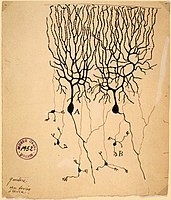
Photo from wikipedia
Calcium (Ca2+) is a second messenger assumed to control changes in synaptic strength in the form of both long-term depression (LTD) and long-term potentiation (LTP) at Purkinje cell dendritic spine… Click to show full abstract
Calcium (Ca2+) is a second messenger assumed to control changes in synaptic strength in the form of both long-term depression (LTD) and long-term potentiation (LTP) at Purkinje cell dendritic spine synapses via inositol trisphosphate (IP3) induced Ca2+ release. These Ca2+ transients happen in response to stimuli from parallel fibers (PF) from granule cells and climbing fibers (CF) from the inferior olivary nucleus. These events occur at low numbers of free Ca2+ requiring stochastic single particle methods when modeling them. We use the stochastic particle simulation program MCell to simulate Ca2+ transients within a three-dimensional Purkinje cell dendritic spine. The model spine includes the endoplasmic reticulum (ER), several Ca2+ transporters, and endogenous buffer molecules. Our simulations successfully reproduce properties of Ca2+ transients in different dynamical situations. We test two different models of the IP3 receptor (IP3R). The model with non-linear concentration response of binding of activating Ca2+ reproduces experimental results better than the model with linear response due to the filtering of noise. Our results also suggest that Ca2+ dependent inhibition of the IP3R needs to be slow in order to reproduce experimental results. Simulations suggest the experimentally observed optimal timing window of CF stimuli to arise from the relative timing of CF influx of Ca2+ and IP3 production sensitizing IP3R for Ca2+ induced Ca2+ release. We also model Ataxia, a loss of fine motor control assumed to be the result of malfunctioning information transmission at the granule to Purkinje cell synapse, resulting in a decrease or loss of Ca2+ transients. Finally, we propose possible ways of recovering Ca2+ transients under Ataxia.
Journal Title: Biophysical journal
Year Published: 2021
Link to full text (if available)
Share on Social Media: Sign Up to like & get
recommendations!